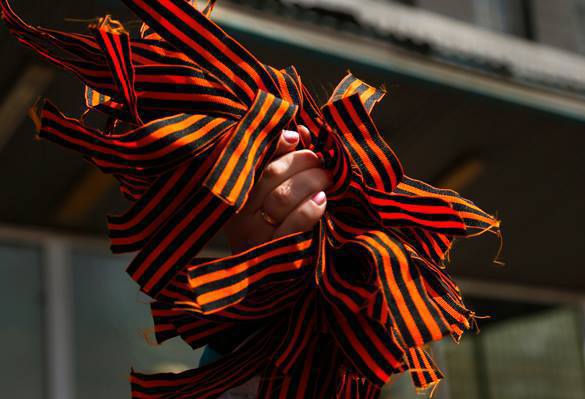Ribbon of St. George remains symbol of courage
Prior to the Victory Day, people hand out St. George's Ribbons - a symbol of military glory and courage - in many countries of the world.

The St. George's Ribbon - a symbol of military glory and courage, a symbol of victory - has become a symbol of remembrance of the great victory and its heroes.
The St. George's Ribbon appeared under Catherine II, together with the Order of St. George, the highest military award of the Russian Empire. At first, it was yellow and black - the colors of gunpowder and fire, - but later the yellow stripes were replaced with orange ones, and the color of fire mixed with the color of blood.
Only 25 military commanders were decorated with the St. George's Ribbon, and only four of them were full holders of the Order of St. George of four degrees: Mikhail Kutuzov, Mikhail Barclay de Tolly, Ivan Varshavsky and Ivan Diebitsch Zabalkansky.
The variant of the order for privates and lower officers - St. George's Cross - appeared soon afterwards. It was also called "Soldier's George" or simply "Egory." Despite the joking nickname, the award was extremely valuable in all respects. It was awarded for uncommon courage displayed during combat actions. In addition to honour, the award raised its holder's salary by one-third and gave an opportunity to privates to become junior officers.
Sometimes, instead of the St. George's Cross, military men would receive only the ribbon from it, when it was impossible to deliver the order itself. This was practiced during the defense of Sevastopol in the Crimean War of the XIX century.
During the War of 1812 and the subsequent campaign against Paris, almost 25,000 of these awards were awarded. During the First World War, when the order had four different degrees - more than a million of awards were awarded. During WWI, St. George's Medal was established - an award for civil individuals working on the front, for example, paramedics and nurses.
The Bolsheviks abolished imperial awards, but in 1943, at the height of the Great Patriotic War, Joseph Stalin decided to retrieve old attributes of military virtue - at first shoulder straps, and a little later, the black and orange ribbon to the Order of Glory. In fact, the Order of Glory is a complete similarity to St. George's Cross. It was awarded to privates and sergeants. There were three degrees of the Order; 2,674 people, including four women, became full holders of the award.
The St. George's Ribbon is commonly known as a part of the medal "For Victory over Germany." This was the most massive military award in the USSR - nearly 15 million people received this decoration - all participants of combat actions, who survived the terrible war.
The popularization of St. George's Ribbon began in 2005. By May 9, all those who remember the heroes of the Great Patriotic War and honor the history, wear the black and orange symbol of victory. This is common practice in Russia, Belarus, Moldova and the Czech Republic. The footage that was made in Berlin before last year's Victory Day, the Germans are seen wearing the St. George Ribbon on their jackets. This year, activists were handing out the black-and-orange ribbons in the streets of New York.
Pravda.Ru
Subscribe to Pravda.Ru Telegram channel, Facebook, RSS!


